This black beauty is simply known as the 2674. This is truly one of the rarest of the rare, Ibanez guitars.
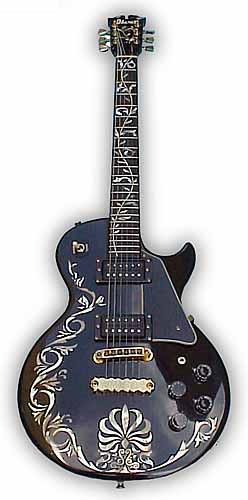 This sample, in excellent condition,
is owned by Californian collector, Harold Wherry.
This sample, in excellent condition,
is owned by Californian collector, Harold Wherry.
How did he nab this black beauty? Harold told me: "I received an e-mail stating the owner had saved an old want ad I had posted on Harmony Central. He decided to sell and contacted me." Hmmm, I guess it does pay to advertise!
Mr. Wherry has owned over 40 Ibanez guitars (his current collection contains 30 guitars). But he has never seen another 2674.

There's not a lot of historic detail known about this guitar. Such as, year of introduction, total years of production, or how many were eventually made. But Harold does have a catalog from 1975 that tells us the following:
- Carved solid maple top, mahogany body
- Ebony Fingerboard with vine of life inlay
- 2-Super 70 pickups, black with open face covers
- Gold Hardware
- Jet Black finish, super inlay
- Fancy engraved artistic tail piece
- Controls: 2 Volume, 2 Tone, 3 way mini-toggle for Phase on Bridge pickup
- Length 41", Width 2", Body 17.5" X 12.5"
- Scale 24.75"
- List $1250.00 (US)
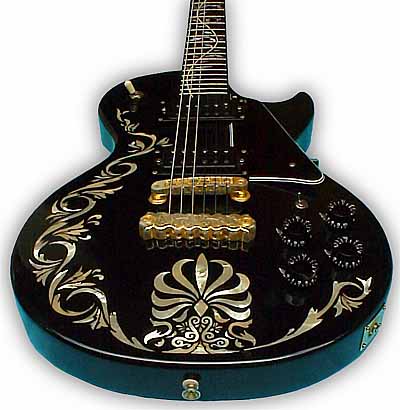
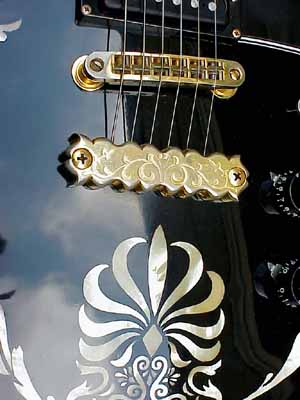 These
next two closeup shots give you a pretty good look at the detail
of the gold plated bridge and tail piece. The picture to the
right also gives you a very nice view of the beautiful MOP inlay
work.
These
next two closeup shots give you a pretty good look at the detail
of the gold plated bridge and tail piece. The picture to the
right also gives you a very nice view of the beautiful MOP inlay
work.
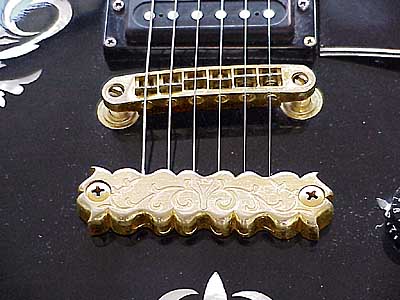
The headstock of the 2674 sports the distinctive scalloped shape common to the entire Ibanez "Professional" line. This would include the Bob Weir (2680 & 2681), Randy Scruggs (2671 & 2671s) and Artwood Twin (2670) models. Note the script-style Ibanez logo. This logo appears to have been in use on some lines into early 1978.
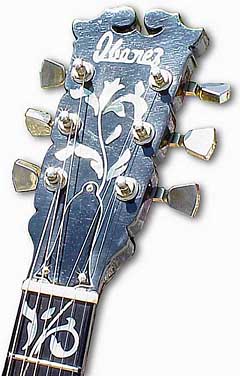
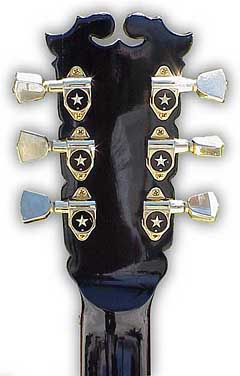
Because there is no a
serial number, it's hard to pinpoint the year for this guitar.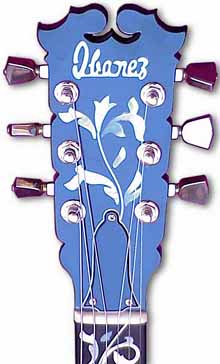 Harold estimates it could be
a 1977.
Harold estimates it could be
a 1977.
Although some of the pictures make it appear that the tuning machines (very nice ones, I might add) are chrome, you can see from the shot below that they are gold plated. Just like all the other hardware on the guitar.

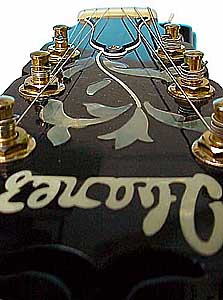 The
lack of binding around the headstock may make it appear that
Ibanez skimped on the frills for this top-of-the-line guitar.
However, when you take a good look at the body of the guitar,
the smooth, non-bound edges really do make sense.
The
lack of binding around the headstock may make it appear that
Ibanez skimped on the frills for this top-of-the-line guitar.
However, when you take a good look at the body of the guitar,
the smooth, non-bound edges really do make sense.
Though, I can't I understand why they wouldn't put the model name or number on the truss rod cover, like all the other Professional models. After all, every great guitar deserves a name (plate), no?
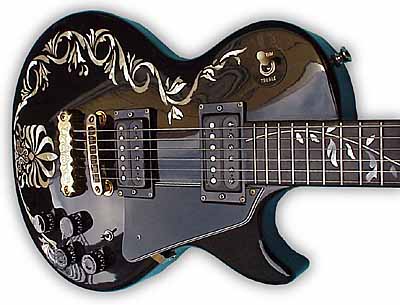
The contours of the slightly-arched, carved maple top, as well as the jet black finish, are captured beautifully in the pictures, above and below.
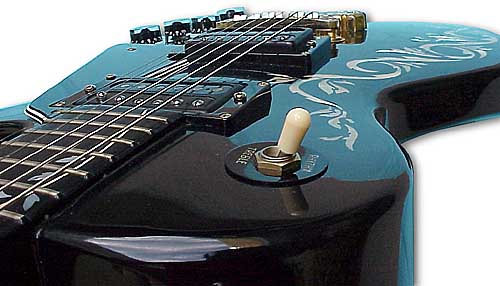
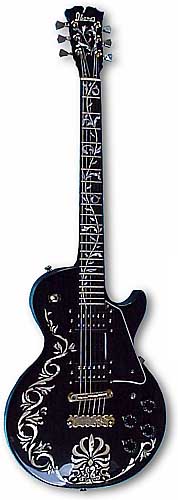 The
ebony fretboard is adorned with the same MOP and abalone vine
of life that graces all the high-end models in the Professional
series.
The
ebony fretboard is adorned with the same MOP and abalone vine
of life that graces all the high-end models in the Professional
series.
Look real close at the end of the fretboard, in the picture below. You'll see that it's bound in black ivoroid binding. At the end of each fret is a small tab from the binding that meets each end of the fret. This is a very nice touch. Unfortunately, trying to preserve these tabs makes the cost of a refret much more expensive.
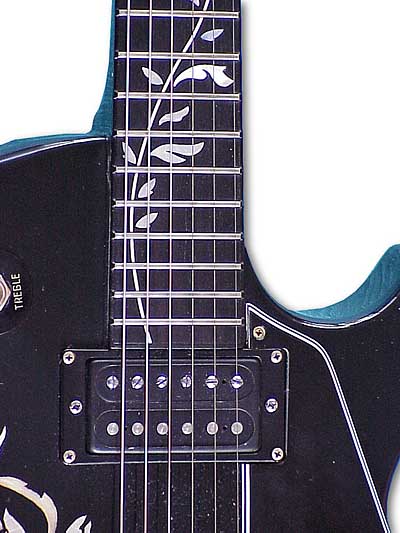
The pickups are Super 70s. And from a distance they appear to have their covers removed, but that's not really the case. Here we see another special touch from the Ibanez factory; the covers are more like cowlings. I guess they figured you get the open humbucker look and sound, and also keep most of the dirt and dust out of the pickup cavities.

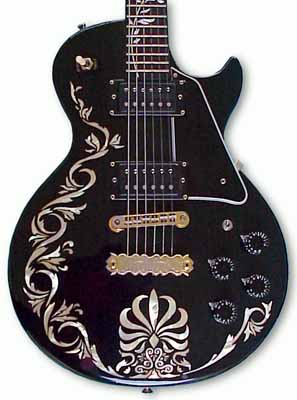 The
black speed knobs are layed out for the standard 2 volume, 2
tone controls of most dual humbucker guitars that follow the
LP way of doing things. However, the mini-toggle, which switches
the bridge humbucker out of phase, is a nice addition.
The
black speed knobs are layed out for the standard 2 volume, 2
tone controls of most dual humbucker guitars that follow the
LP way of doing things. However, the mini-toggle, which switches
the bridge humbucker out of phase, is a nice addition.
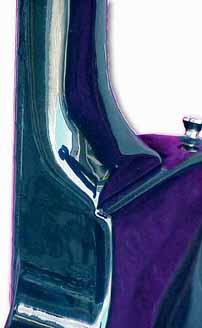
The heel and neck joint are similar to your average LP. It looks like Ibanez saved the truly innovative construction techniques, like the "smooth heel", for other models, such as the Bob Weir. They did improve on the back by sculpting out some of the waist, between the upper and lower bouts.
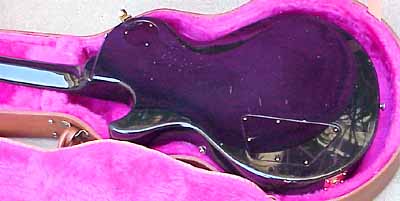 Another
similarity it has with it's LP inspiration is weight. Harold
hasn't weighed it, but says it's about the same as an LP Standard.
Being that it came with no case at all, Mr. Wherry has to keep
it in the brown LP case seen above. Dig that pink interior!
Another
similarity it has with it's LP inspiration is weight. Harold
hasn't weighed it, but says it's about the same as an LP Standard.
Being that it came with no case at all, Mr. Wherry has to keep
it in the brown LP case seen above. Dig that pink interior!
We are certainly very grateful to Harold for sharing these fantastic pictures of his prize-winning 2674 with Ibanez Collectors World.
Oh, we forgot to tell you how it plays! We'll let Mr. Wherry tell you, in his own words: "The guitar plays and sounds excellent, it's got soul...I am very thankful I have possession of this guitar. It's a real treat to play and admire."
 Home Page | ICW Forum
Home Page | ICW Forum